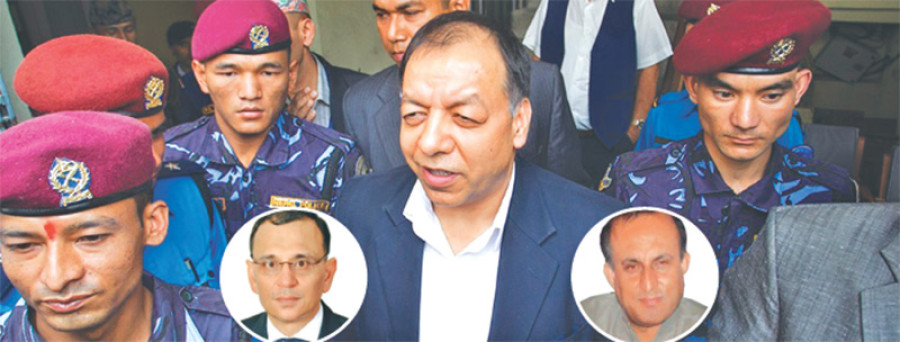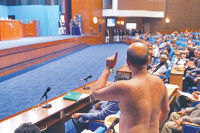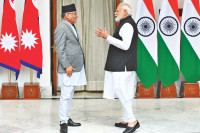Special Supplement
Biggest corruption case in Nepal’s history
On July 16, the Commission for the Investigation of Abuse of Authority (CIAA) filed cases against three members of the Tax Settlement Commission (TSC) at the Special Court on the charge of embezzling Rs10.02 billion in what is the biggest corruption case in Nepal’s history.
Prithvi Man Shrestha
On July 16, the Commission for the Investigation of Abuse of Authority (CIAA) filed cases against three members of the Tax Settlement Commission (TSC) at the Special Court on the charge of embezzling Rs10.02 billion in what is the biggest corruption case in Nepal’s history. The anti-graft watchdog has demanded Rs 33 billion in fines from the three of them, besides jail terms of eight to 10 years. The embezzled amount could be much higher once the CIAA completes all 1,069 files related to tax settlement, CIAA officials say. The case was filed at the Special Court after an investigation into files of 45 companies with tax settlements worth more than Rs 10 million. The biggest ever case filed by the CIAA before this was against eight staffers of the Itahari Transport Management Office for misappropriating Rs 612.12 million.
The case has aroused strong public interest after the CIAA took serving director general of the Inland Revenue Department (IRD) and TSC member Chudamani Sharma into custody on June 2. Sharma has a controversial history of alleged irregularities and is reported to be well connected with former CIAA chief commissioner Lok Man Singh Karki. Following his arrest, Sharma’s wife Kalpana Upreti filed a habeas corpus writ at the Supreme Court on July 11 demanding that her husband be released as the CIAA did not have the authority to take legal action against him. On August 11, the Supreme Court released him on general date but let the Special Court proceed with the corruption case against him, much to the relief of the CIAA which feared that the Supreme Court might bar it from continuing the probe against him. Subsequently, the Special Court issued summons to Sharma and two other TSC members, chairman Lumba Dhwoj Mahat and member Umesh Dhakal, who surrendered on November 16. The Special Court has released them on bail of Rs 100 million each.
How the investigation began
Questions were raised about the conduct of the TSC after a report of the Office of the Auditor General (OAG), released last April, highlighted the dubious way in which tax exemptions worth Rs21 billion had been granted. The parliamentary Public Accounts Committee (PAC) then wrote to the CIAA asking it to investigate the matter. The anti-graft body had also received a few complaints about the conduct of the TSC. On February 14, the CIAA formed a three-member committee led by since retired joint secretary Jibraj Koirala and conducted an initial investigation. The panel team submitted its report to the CIAA on March 16 which stated that the TSC had signed agreements with the taxpayers with the intention of causing harm to the state by going against the spirit of the TSC Act, overstepping its jurisdiction and settling tax liabilities without analysing the capacity of the taxpayers.
The report prompted the CIAA to conduct a detailed investigation and it appointed an investigation committee on March 20. The CIAA then asked for all the documents related to the tax settlement from Sharma. “He continued refusing to send the documents arguing that he did not have them as the TSC’s term had ended,” said a CIAA official. On April 28, the CIAA wrote to the Finance Ministry asking for the documents. On April 30, the Finance Ministry instructed the IRD to hand over the paperwork to the CIAA. The IRD wrote back to the CIAA saying that it did not have jurisdiction over the TSC and so could not provide the documents. This prompted the CIAA to write another letter to Sharma to present himself with the documents on June 2. “He came to the CIAA but he did not bring the documents with him. We then took him under our control by notifying him of his arrest on the same day,” said the CIAA official.
After his arrest, the CIAA started to get all the documents related to the TSC from the IRD, although Sharma had claimed that it did not have them, according to CIAA officials. As many as 1,069 files related to tax settlements were recovered. “But he hardly cooperated with us as we conducted our investigation,” said a CIAA official, adding that he hardly gave a straight answer to their questions and got himself admitted to hospital several times on the pretext of being sick. However, the documents recovered from the IRD provided irrefutable evidence that tax settlements had been made in a questionable manner, the official said.
Questionable settlements
In its charge sheet, the CIAA has said that tax exemptions were given to certain enterprises without any concrete reason for doing so. For example, in the case of Ncell, tax authorities had determined the amount of tax at Rs 1.82 billion but the TSC settled the issue with a payment of only Rs 900 million. “Although Ncell has the capacity to pay this amount of tax, and there was no concrete reason of exempting tax, the company was given a tax exemption with the ill intention of causing loss to the government,” the charge sheet says.
Likewise liquor companies which were capable of paying tax were given tax exemptions on a large scale. In fact, five liquor companies alone got the highest tax exemption of Rs 7.66 billion. According to the charge sheet, TSC members overstepped their jurisdiction. As per the TSC Act, the TSC can handle cases only after they are withdrawn from the revenue tribunal. However, the TSC settled tax cases of 32 enterprises who had not withdrawn their appeals from the revenue tribunal.
Even enterprises that took value added tax (VAT) paid by the general public were given tax exemptions. As many as 20 companies that were involved in fake VAT bill scandals in the past were also given tax exemptions. The TSC members also falsified their reports to the government by showing a lower amount than the actual amount of tax exemption. For example, the tax exemption given to Triveni Distillery stands at Rs 4.01 billion in the charge sheet, while the TSC report shows the company was given a Rs3.29 billion tax exemption, according to the charge sheet.
CIAA officials said these evidences show that TSC members acted in dubious ways to benefit themselves and those taxpayers at the expense of the state. However, experts question whether the TSC members alone should be made responsible for such large scale tax exemptions. “If they are brought to book, those who formed the TSC should also be held accountable,” said Surya Nath Upadhyay, former chief commissioner of the CIAA.
Question of jurisdiction
Clause 17 of the TSC Act says, “No case or legal action may be instituted or taken against the Commission, any member of the Commission or any person acting as per the order and direction of the Commission for any act and action done or taken or purported to be done or taken in good faith in accordance with this Act or the Rules framed under this Act.” The protection provided by this provision seems to have encouraged TSC officials to take questionable decisions regarding tax settlement.
In its verdict on August 11, the Supreme Court acknowledged this provision of the Act when it decided to release Sharma on general date. But the court stated, “There still is a dispute whether Sharma performed his duty in good faith as a TSC member or abused his authority for corruption.” The Supreme Court has let the Special Court decide whether the TSC members overstepped their jurisdiction regarding the corruption case filed against him.
The case has also raised questions over the relevance of the TSC Act itself. TSC Act was introduced during a time when there was no legal provision for a self-assessment based tax system in Nepal. Taxpayers in the past used to think that enterprises should have a higher tax bill every successive year irrespective of their income, which made the TSC relevant in those days. “The introduction of the Income Tax Act 2002, which allowed taxpayers to make a self-assessment of their tax liability and pay it, has ended the relevance of the TSC,” said former auditor general Bhanu Acharya. The Act also contains a provision stating that taxpayers can appeal to the IRD Director General and the Revenue Tribunal if they feel that the decision of the tax official is unjustified. “The OAG report has questioned the relevance of the TSC even in the past. The latest episode has made it clear that the Act is no longer relevant,” said Acharya.
CIAA officials say the alleged ‘misuse of the Act for personal benefit’ by the TSC members would force the government to rethink forming such commissions in the future. “This case, in fact, will help strengthen the tax system,” said a CIAA official.
Restoring public trust in the CIAA
People’s faith in the CIAA had sunk when it was headed by Lok Man Singh Karki. During his term, the CIAA saw its jurisdiction curtailed by the new constitution to oversee ‘improper conduct’ by public officials, limiting its jurisdiction only to corruption cases. An impeachment motion against Karki and his subsequent dismissal from the anti-corruption body through a Supreme Court verdict pushed the CIAA into the defensive at a time when it was seeking to expand its authority and jurisdiction to look into corruption cases involving even the private sector.
Then came the day when the CIAA took former IRD DG Sharma under its custody on June 2. The CIAA’s stock suddenly rose. It got strong backing from the media and the public after the arrest of Sharma who had a controversial past in terms of irregularities. “Obviously, our action against the TSC members generated goodwill towards the CIAA,” said CIAA Commissioner Ganesh Raj Joshi. The action against Sharma was a timely morale booster for the CIAA as its morale had dropped following the removal of Karki. Former CIAA chief commissioner Upadhyay believes that with the action against the TSC members, the CIAA has been able to regain the trust of the public which had eroded due to revenge-driven actions under Karki.




 5.17°C Kathmandu
5.17°C Kathmandu










